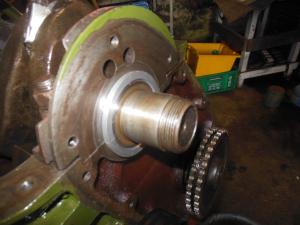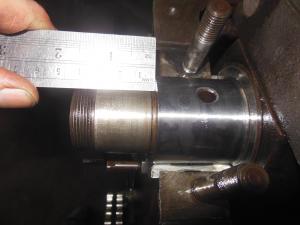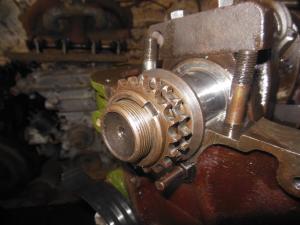Crankshaft end float mystery
Traction Owner’s Club › Forums › Technical › Engine › Crankshaft end float mystery
- This topic has 8 replies, 3 voices, and was last updated 5 years, 4 months ago by Bernie.
-
AuthorPosts
-
16th August 2020 at 2:05 pm #27308
Richard Larter
ParticipantI am completing a major engine rebuild on my 1940 Light 15 and have hit a problem, the crankshaft end float has disappeared. The crankshaft had a regrind and new main bearings fitted and needs to be set up with 0.10mm end float controlled by shims between the crankshaft sprocket and the main bearings. However the plain section on which the sprocket sits is 29mm long but the sprocket is 26mm long and the thrust washer is 5mm thick giving a negative end float. I can only assume the sprocket was not tightened up fully and the big nut was prevented from loosening by the tab washer! Perhaps a thicker sprocket from a later engine has been fitted so can anyone shed any light on this before I get the sprocket machined down to create a clearance.
Cheers Richard


 17th August 2020 at 9:45 am #27310
17th August 2020 at 9:45 am #27310Philippe Allison
ParticipantHi Richard,
The end float is not affected by the thickness of the sprocket. The shims go onto the crankshaft just behind the large thrust washer. So end float is achieved by moving the thrust washer away from the bearing cap. So the shims should be no larger in diameter than the main beaing journal so that they can fill the “void”. Does this make sense. If you are still unsure I am happy to talk on the phone 07899 658634.
p.s. Best practice says that the sprocket and thrust washer should be nipped up before the final torqued tightening of the main bearing cap, this will ensure it is tightened with both upper and lower halves in contact with the thrust washer.
Good luck Philippe.
17th August 2020 at 1:41 pm #27311Richard Larter
ParticipantHi Phillipe
I understand that is how it should work but if I fit the sprocket with just the thrust washer there is no clearance and the crankshaft is locked solid and the nut is still not fully tightened hence the mystery. So I wonder if the sprocket is incorrect, is a sprocket thickness of 26mm correct for the Perfo engine?
Cheers Richard
18th August 2020 at 7:39 pm #27320Philippe Allison
ParticipantMaybe I have not explained very well. The sprocket thickness is irrelevant. When I set up the end float I have a tube that I use to replace the sprocket that is an easy slide fit on the crank, this saves the bother of trying to remove the sprocket in between each trial fitting.
The shims are the first pieces to slide onto the crankshaft and they space the thrust washer away from the main bearing caps, they effectively make the journal longer.
So:
1. Fit crankshaft ensuring the thrust faces are flush, torque down and check free rotation.
2. Slide shims onto the crank.
3. Fit thrust washer, sprocket (no woodruff key at this stage)
4. Tighten nut to correct torque.
5. Measure end float.
6. Add or remove shims to achieve correct end float.
7. Re-assemble with timing chain and woodruff key.
8. Tighten to correct torque.
Regards Philippe
18th August 2020 at 7:52 pm #27321Philippe Allison
ParticipantRichard,
Watch this youtube video from 24 minutes in, not the same engine but exactly the same principle.
Philippe
19th August 2020 at 10:06 am #27325Philippe Allison
ParticipantRichard,
Sprocket thickness is 26mm (25.97)
19th August 2020 at 12:37 pm #27327Bernie
ParticipantRichard,
Like Phil, I cannot envisage what is causing your problem because end float adjustment is not st all dependent on the timing sprocket thickness as the video clearly shows
Could there be something else blocking the shaft and/or it’s various components.
Please can you post pictures of all your bits loose and then assembled in the block?
Ta,
B…
19th August 2020 at 8:53 pm #27329Richard Larter
ParticipantHi Philippe and Bernie
Thank you for all your help, I have now resolved the mystery. My engine was rebuilt without shims so I did not know what size they were and the diagram in the parts book shows them as the same size as the thrust washer which would mean they would bear against the main bearing cap hence my problem. I had a conversation last night with Andy Burnett, the Scottish Traction guru who told me the shims were smaller than the thrust washer and were nipped up against the crankshaft, not the bearing cap and it suddenly it all made sense. Andy is sending me some shims so hopefully I will be up and running in the near future. Every day is a school day.
Cheers and thank you again for your help.
Richard
20th August 2020 at 8:23 am #27330Bernie
ParticipantExcellent news. The video posted by Phil did show the washers being in a recess but I can understand it might be missed if one is not expecting to see that.
B….
-
AuthorPosts
- You must be logged in to reply to this topic.
